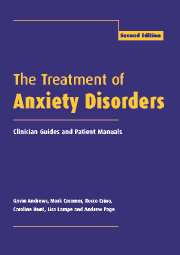Book contents
- Frontmatter
- Contents
- List of authors
- Preface to the second edition
- Abbreviations
- 1 Read me
- 2 General issues in anxiety disorders
- 3 General issues in treatment: Clinician Guide
- 4 Panic disorder and agoraphobia: Syndrome
- 5 Panic disorder and agoraphobia: Treatment
- 6 Panic disorder and agoraphobia: Clinician Guide
- 7 Panic disorder and agoraphobia: Patient Treatment Manual
- 8 Social phobia: Syndrome
- 9 Social phobia: Treatment
- 10 Social phobia: Clinician Guide
- 11 Social phobia: Patient Treatment Manual
- 12 Specific phobias: Syndrome
- 13 Specific phobias: Treatment
- 14 Specific phobias: Clinician Guide
- 15 Specific phobias: Patient Treatment Manual
- 16 Obsessive-compulsive disorder: Syndrome
- 17 Obsessive-compulsive disorder: Treatment
- 18 Obsessive-compulsive disorder: Clinician Guide
- 19 Obsessive-compulsive disorder: Patient Treatment Manual
- 20 Generalized anxiety disorder: Syndrome
- 21 Generalized anxiety disorder: Treatment
- 22 Generalized anxiety disorder: Clinician Guide
- 23 Generalized anxiety disorder: Patient Treatment Manual
- 24 Posttraumatic stress disorder: Syndrome
- 25 Posttraumatic stress disorder: Treatment
- 26 Posttraumatic stress disorder: Clinician Guide
- 27 Posttraumatic stress disorder: Patient Treatment Manual
- 28 Conclusions
- References
- Index
22 - Generalized anxiety disorder: Clinician Guide
Published online by Cambridge University Press: 05 August 2016
- Frontmatter
- Contents
- List of authors
- Preface to the second edition
- Abbreviations
- 1 Read me
- 2 General issues in anxiety disorders
- 3 General issues in treatment: Clinician Guide
- 4 Panic disorder and agoraphobia: Syndrome
- 5 Panic disorder and agoraphobia: Treatment
- 6 Panic disorder and agoraphobia: Clinician Guide
- 7 Panic disorder and agoraphobia: Patient Treatment Manual
- 8 Social phobia: Syndrome
- 9 Social phobia: Treatment
- 10 Social phobia: Clinician Guide
- 11 Social phobia: Patient Treatment Manual
- 12 Specific phobias: Syndrome
- 13 Specific phobias: Treatment
- 14 Specific phobias: Clinician Guide
- 15 Specific phobias: Patient Treatment Manual
- 16 Obsessive-compulsive disorder: Syndrome
- 17 Obsessive-compulsive disorder: Treatment
- 18 Obsessive-compulsive disorder: Clinician Guide
- 19 Obsessive-compulsive disorder: Patient Treatment Manual
- 20 Generalized anxiety disorder: Syndrome
- 21 Generalized anxiety disorder: Treatment
- 22 Generalized anxiety disorder: Clinician Guide
- 23 Generalized anxiety disorder: Patient Treatment Manual
- 24 Posttraumatic stress disorder: Syndrome
- 25 Posttraumatic stress disorder: Treatment
- 26 Posttraumatic stress disorder: Clinician Guide
- 27 Posttraumatic stress disorder: Patient Treatment Manual
- 28 Conclusions
- References
- Index
Summary
The present chapter aims to guide clinicians in the principles of treatment and the use of the treatment Manual, as well as highlight some of the more common problems encountered in therapy. fihile further studies are needed to identify the active components of effective treatment for generalized anxiety disorder, it appears that two core elements are:
•An underlying rationale, based on the ‘coping skills’ model of cognitive
behavioral therapy, where patients are taught skills to manage their anxiety and
to take responsibility for change and control over their thoughts, feelings, and
behavior.
•Cognitive therapy with the goal of bringing the process of worry under the
patients control.
Relaxation training, usually a form of progressive muscle relaxation, is a useful adjunct to treatment, particularly where the effects of chronic and high levels of muscle tension trouble an individual.
Assessment
It is assumed that before the commencement of treatment, a clinical assessment will have ruled out comorbid diagnoses in need of immediate specific treatment, such as a major depressive episode. fihere depression is present, it becomes the treatment priority and the need for further treatment of anxiety symptoms reviewed when the depression is resolved. Given the phenomenological similarities between the two disorders, it is often necessary to establish from historical information whether GAD existed before the onset of a major depressive episode, or to assess whether a GAD continues to exist following effective treatment of the depressive disorder.
fihile patients with a primary diagnosis of GAD will not always meet criteria for another diagnosis, they will often have concerns and behaviors that are characteristic of other anxiety disorders. Panic attacks, social anxiety, phobic avoidance, obsessions, and illness anxiety are common. The treating clinician will therefore need to be able to recognize these different features and address these in the course of treatment. For example, some time can be spent focusing specifically on fears of scrutiny and negative evaluation or fears that a physical sensation is really a sign of a serious, life-threatening illness within the framework of the cognitive behavioral approach. The use of a slow-breathing exercise (possibly due to its meditation-like features) can provide temporary control over acute episodes of high anxiety for many individuals. Hence patients can be relatively quickly provided with an increased sense of control that allows them to recognize the triggers of their anxiety and implement cognitive strategies.
- Type
- Chapter
- Information
- The Treatment of Anxiety DisordersClinician Guides and Patient Manuals, pp. 407 - 416Publisher: Cambridge University PressPrint publication year: 2002



